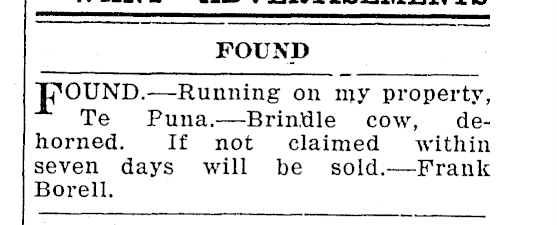 |
| DP22854 colour map of Borell Road western end 1929 LINZ database, accessed at Tauranga City Library |
Early surveyors ruled light red lines across the landscape to indicate where they thought roads might feasibly go. Theophilus Heal correctly guessed one would run out towards Te Kariti (approximately the route of the present Te Puna Road) and one to the northeastern mouth of the Waikaraka estuary. He even essayed a lateral connection [3], one that took the traveller across the neck of the Waikaraka, where Waikaraka Drive, and its eastern connection, are today.
 |
| Looking west towards Paparoa marae. Photo: Beth Bowden |
 |
| Signpost, western end Borell Road. Photo: Beth Bowden |
 |
| SO25276 Borell Road land to be taken May 1929 LINZ database, accessed at Tauranga City Library |
But the settlers persisted. In April 1928 Messrs A. W. Snodgrass, F. H. Allen, W. Phipps, A. W. Anderson, J. Knox and H. Storer had signed “a petition for the declaration of a special rating area… [for] Borell’s Road at Te Puna, and the object is to raise a loan of £250.” County Councillors poured cold water. Such loans were detrimental to financial administration, and the application would be entertained only so far as legalising the road “when all formalities have been complied with.” [9]
 |
| Signpost, eastern end Borell Road. Photo: Beth Bowden |
Next month they were back again, this time with their womenfolk. [10] C.E.H and Mrs Allen, Mr and Mrs Knox and their daughter, and a Miss Snodgrass, as well as Messrs Snodgrass and Phipps, formed a deputation to urge the acquisition of Borell Road. [11] Produce could not go out; manure could not be brought in. “Only a culvert required fixing.” Perhaps the loan should be increased; the settlers were “paying a little over £122 per annum in rates and at present had no access.” At this point a mystifying (to me at least), mollifying letter, proposing an alternative roadway from the Minister was read out: it cut no ice at all. The road the settlers wanted, “now”, “was along the railway and went through Messrs Borell’s and Allen’s properties.” Councillors’ comments as reported in the Bay of Plenty Times [12] read as both supportive - and circumspect.
By August Werahiko had rallied his forces. Interestingly, he invoked the importance of the Crown; and of boats. In his representations to the Council he rejected the idea of a loan, relied on the Minister’s letter and reserved “the right of my boat landing on the Oturu Stream, as it is a great benefit to me and my family for our boats to go out to earn my living by fishing in the harbour ...” This too cut no ice. Councillor Darragh successfully moved that the Council apply for a loan of £250 for the purposes of “acquiring, constructing, fencing and legalizing Borell’s Road, Te Puna.” [12]
The loan, the Gazette notice, and the surveys went through despite continued opposition from Werahiko and his family. [14] And the settlers were discontented as well. Even in October 1930 the road was “surveyed and fenced, but the road was not made”. [15] They were soothed by promises and, eventually, metal from the Te Puna Quarry. Frank junior, full of spirit even four years later, pushed back at the Council about impediments to access along Youngson’s Road. [16] Back in Te Puna, Werahiko was dealing with stock that found the new road a convenient browsing route. [17] Meanwhile, on Snodgrass Road, subdivision, especially along the harbour frontages of the Waikaraka, was becoming commonplace. [18] By 1947, the main problem on Borell Road was the gorse [19] ...
 |
| Railway line and culvert, Borell Road. Photo: Beth Bowden |
[1] See SO424, the map drawn in 1865 by Theophilus Heal, Surveyor. A copy is in the Tauranga Library.
[2] Conversation with Billy Borell, 6 February 2020. Possibly a contraction of paepae roa. I am indebted to the Borell family for their support for my recounting this story of their tipuna Werahiko.
[3] ibid SO424
[4] But still challenging: the Borell Road section of the ECMT is one of the steepest on the whole line.
[5] The settlers seem to have called it Borell’s Road from very early in the process: see their petition of April 1928, reported at https://paperspast.natlib.govt.nz/newspapers/BOPT19280414.2.13
[6] https://paperspast.natlib.govt.nz/newspapers/BOPT19270312.2.17
[7] https://paperspast.natlib.govt.nz/newspapers/BOPT19270409.2.4 It is not clear whether Werahiko ever accepted compensation, worth about $5,000 in $NZ today: https://www.rbnz.govt.nz/monetary-policy/inflation-calculator
[8] https://paperspast.natlib.govt.nz/newspapers/BOPT19280116.2.12
[9] https://paperspast.natlib.govt.nz/newspapers/BOPT19280414.2.13
[10] It is worth pointing out that the status of women as land holders, and therefore ratepayers, in the Tauranga County was by this time well established.
[11] https://paperspast.natlib.govt.nz/newspapers/BOPT19280518.2.17
[12] ibid
[13] https://paperspast.natlib.govt.nz/newspapers/BOPT19280815.2.11
[14] https://paperspast.natlib.govt.nz/newspapers/BOPT19290523.2.14 ; https://paperspast.natlib.govt.nz/newspapers/BOPT19290916.2.14 ; https://paperspast.natlib.govt.nz/newspapers/BOPT19291014.2.10
[15] https://paperspast.natlib.govt.nz/newspapers/BOPT19301011.2.19

Nga mihi nui Beth Bowden for this meticulously researched article. Very interesting early historical information about how local Maori fought back from the greed of the governing colonist and settlers.Kiaora Beth.
ReplyDeleteKia ora e hoa and thank you for your comments. I am very very interested in researching changes in land use in Te Puna and am also very impressed at the tenacity shown by Maori and Maori/French families in maintaining their diminished whenua. Te Puna would not be the same without them. Nga mihinui to the Borell family also, who allowed me to tell this tiny slice of their story - and for Borell Road itself. Te Puna would not be the same without it, as well! Heio ano, na Beth
Delete